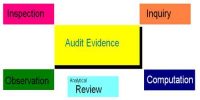Phases of a Financial Audit
A financial statement audit is an engagement performed by an independent accountant to provide assurance that an entity’s financial statements are reported in accordance with accounting principles generally accepted. Specifically, certified public accountants, or CPAs, are obtained to provide audited financial statements to businesses, nonprofit organizations, and government agencies. Each audit is customized to meet the needs of the organization. However, the overall approach to every audit is the same.
(a) Engagement Acceptance: The American Institute of CPAs recommends that an auditor evaluate the risks associated with each engagement. Therefore, a CPA inquires about any special circumstances, the integrity of management and pending lawsuits before performing an audit. In addition, the auditor evaluates the staffing needed to complete the engagement and determines that each staff members are able to maintain an independent viewpoint while performing the engagement. Once the auditor decides to accept the engagement, an engagement letter is prepared that details the timing, responsibility, and cost of the audit.
(b) Planning: Auditing standards require that an auditor prepare adequate planning for an engagement. The amount of audit planning needed is in direct relation to the size and complexity of the organization. Audit planning involves obtaining an understanding of the organization’s business and industry, performing trend and ratio analysis, documenting the entity’s process of internal control and assessing the risks of misstatements in the entity’s financial statements. The auditor utilizes the results of the planning process to determine the timing and extent of audit testing.
(c) Audit Tests: During the fieldwork process, or the time the auditor spends at the organization and offices, the auditor performs tests of financial data. For instance, a CPA selects a random sample of forty disbursements to ensure checks are payable to the correct vendor and are written for the correct amount. In addition, an auditor reviews the invoice associated with the disbursement to ensure the expense is classified correctly and that the vendor actually exists. Depending on the results of the planning process, the auditor performs a variety of tests on financial statement accounts.
(d) Account Analysis: During the account analysis process, the auditor ensures that financial statement account balances are supported by underlying documentation and analysis. A CPA evaluates the results of tests, reviews management, and responses to inquiries and records audit-adjusting journal entries. Furthermore, the auditor documents reasons for large changes in accounts from year to year and performs any necessary research regarding requirements under generally accepted accounting principles.
(e) Reporting: CPAs issue an opinion on audited financial statements as to whether the financial statements are presented in accordance with accounting principles generally accepted. The opinion is issued on the Independent Auditor Report. Furthermore, the auditor may also draft the basic financial statements and the accompanying notes for the organization and management. The auditor also issues a report on any weaknesses found in the entity’s internal control process.
(f) Summation: An auditor is required to retain proper documentation regarding the audit and obtain signatures from management regarding management’s responsibility for the information reported in the financial statements. The information is retained by the CPA should lawsuits occur regarding reported amounts and for future account analysis.
















